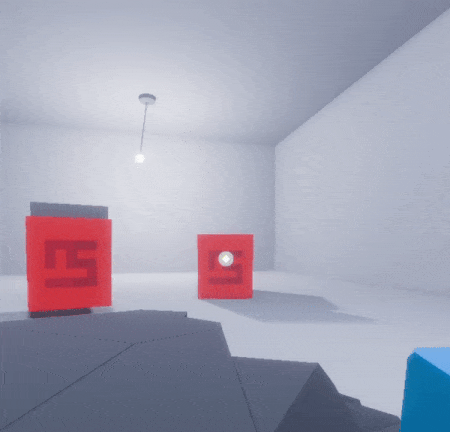Ok, this one was highly interesting due to its original concept and its experimental nature. I made it until the third level with the turret. Unfortunately, that's where it became too frustrating for me to continue. More on that later.
First off, the presentation is great and the audio feedback is fantastic! The game is visually very pleasing.
The core idea of giving your bullets a curved trajectory sounds super fun and alluring. The problem I see is that curves in a 3D space can become very complex and it's very hard to make a reliably aimed shot without depth perception. I would even argue, that our stereoscopic vision wouldn't be sufficient to make a reliable curved shot. Our depth perception works well when we want to make qualitative estimates like "A is more in front of B" or "X is moving away or moving towards me". But on a quantitative level I think it's not that accurate.
What I found myself doing was trying out different trajectories and successively adjusting my spin to the shots I was observing. This works well on stationary targets. Moving targets required far more attempts. The default vertical sway of the gun didn't do much for me. Maybe I was missing something, but I ended up holding down RMB at all times trying to give my shots more controlled spins.
In the second level I tried to hit the enemies by ricocheting my bullets off the walls because curved shots had a greater chance to hit the shield and bounce back at me. Once the enemies turned towards the direction my bullet hit them from, I could finish them with straight shots.
The third level, as mentioned before, was where I eventually gave up. At first it wasn't clear to me that I had to hit the target from behind. I started to play around, and one of my many bullets hit the turret by accident, triggering the hurt sound. The target was way smaller than the shield guys in the previous level and way harder to hit. I only managed to hit it once or twice by sheer luck before getting a laser beam in the face.
Overall, I think this is a very valuable experiment. Despite the trouble I had with it, I wouldn't abandon the idea of curved bullet shooters. Maybe you were also trying to do too much in one go. The mouse-controller-stick-hybrid input is interesting but I'm not sure if the combination of those two quite idiosyncratic concepts benefits the experience. If you'd ask me, I would try to make the curved trajectory mechanic more approachable (add a simple trajectory indicator on the crosshair? Try it without the vertical weapon sway? Variable game speeds as you already have when changing position but when aligning your shot.) and design enemies and play environments around that.
You've made a very compelling prototype for an interesting mechanic. It answers a lot of questions and it might be a major stepping stone for a unique game in the future.


